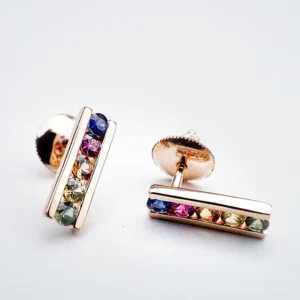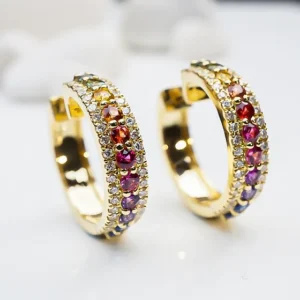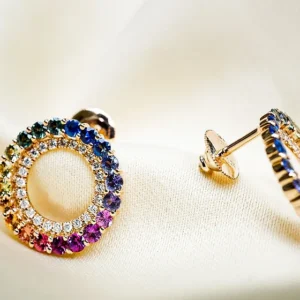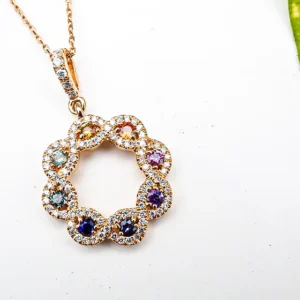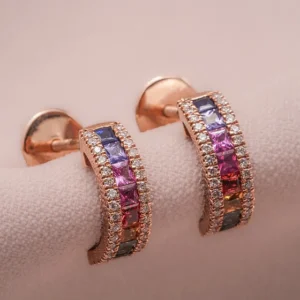Unearthing the Allure of the Ruby Gemstone: A Deep Dive
Ruby stone enthusiasts and gemstone aficionados alike have been captivated by the timeless allure of rubies. These stunning gemstones, known for their vivid crimson hue and extraordinary beauty, have held a special place in the world of jewelry and symbolism.
Table of Contents
In this comprehensive guide, we will take you on a journey to explore the secrets and wonders of the ruby gemstone, covering its origins, distinct characteristics, cultural significance, and more.
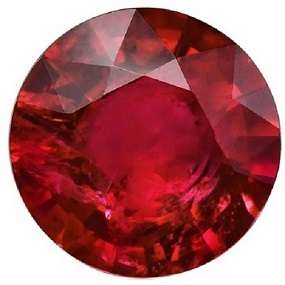
A Red Ruby
Introduction
The mesmerizing allure of the ruby stone has fascinated jewelry enthusiasts for centuries, weaving a tale of romance and fascination that transcends time. With its deep crimson hue reminiscent of burning passion and unwavering love, rubies are not merely gemstones; they are embodiments of emotion and style, encapsulating the profound narratives of those who wear them.
In this captivating article, we invite you to join us on an enchanting journey through the world of rubies, where we will delve into their origins, delve into their distinct and captivating characteristics, decode the symbolism they carry across cultures, and celebrate their role as treasured jewelry pieces that whisper tales of elegance and opulence.
Origins and Formation of Rubies
Ruby gemstones, resplendent in their breathtaking allure, belong to the corundum family, their exquisite signature red color owed to the enchanting dance of chromium within their crystalline framework. This mesmerizing transformation unfolds over countless eons, as these precious gems undergo a remarkable metamorphosis deep within the Earth’s nurturing embrace.
Born under the intense duet of heat and pressure, their journey from the bowels of the Earth to the surface is an awe-inspiring marvel of nature, a testament to the intricate symphony that shapes the very fabric of our planet’s treasures.
Distinctive Characteristics of Rubies
The allure of rubies is a multi-faceted marvel that transcends mere aesthetics, encompassing both their striking red color and their exceptional durability. With a commendable hardness score of 9 on the Mohs scale, rubies stand as a testament to nature’s craftsmanship, second only to the remarkable hardness of diamonds.
This inherent durability not only allows rubies to withstand the tests of time but also positions them as ideal candidates for everyday wear, gracefully adorning a variety of jewelry pieces.
Beyond their resilience, rubies possess an innate ability to harness and reflect light, creating a captivating interplay of luminosity that bestows upon them an unmistakable and irresistible sparkle, a dance of radiance that effortlessly captures the gaze of all who behold their beauty.
The Cultural Significance of Ruby Gemstones
Throughout the annals of history, rubies have stood as enduring emblems of profound emotions, embodying the essence of passion, vitality, and boundless love that transcends eras and cultures.
Revered as vessels of sentiment, these precious gems have woven themselves into the very fabric of societies across the globe, where they are hailed as potent talismans of protection and power, guardians of the wearer’s spirit.
In certain cultures, the connection runs even deeper, as rubies are intricately linked to the July birthstone, a radiant tribute to the hearts born under the warm embrace of summer’s sun.
Thus, these gemstones, adorned with their fiery hues, take on the role of cherished companions as the ruby birthstone for July, offering a gift of meaning and resonance to those who mark their existence in the month of July.
Factors Influencing Value: The 4 Cs of Red Rubies
Carat Weight
The concept of carat weight holds a captivating dimension when it comes to rubies, offering a glimpse into the gem’s intrinsic qualities. As a determinant of size, carat weight in rubies interplays with their color, cut, and clarity, influencing their overall visual impact.
While larger rubies may command attention, it’s the harmonious balance between carat weight and other characteristics that truly enhances their allure.
Whether opting for a single, statement-making ruby or an arrangement of smaller yet equally enchanting gemstones, the choice of carat weight becomes a canvas upon which the gem’s inherent beauty is painted, offering a spectrum of possibilities that cater to diverse tastes and preferences.
Color
Color is a paramount attribute in the realm of rubies, encapsulating the very essence of their allure. Ranging from velvety crimson to delicate pinkish-red hues, the spectrum of colors within rubies holds a mesmerizing journey. The depth and intensity of a ruby’s color are a testament to its value and rarity, with the famed “pigeon blood” red regarded as the pinnacle of perfection.
Beyond its aesthetic charm, the color also offers a glimpse into the gem’s origin and quality, where the interplay of hues evokes emotions ranging from fiery passion to elegant grace. The artistry of a ruby’s color extends beyond its surface, resonating with the soul of the gem, capturing the very essence of its enduring fascination.
Clarity
Clarity, an intrinsic trait of rubies, unveils a world of visual purity that is as captivating as it is unique. While some gemstones emphasize transparency, rubies often display inclusions, referred to as “silk.” These delicate needle-like formations give each ruby its distinctive fingerprint, adding an ethereal quality to the gem’s internal landscape.
Unlike other gemstones where clarity is prioritized, in rubies, these inclusions are not just tolerated, but often celebrated for their role in authenticating the gem’s natural origin. The play of light and color within the silky inclusions creates an otherworldly effect, infusing the gem with a sense of depth and mystique.
As a result, clarity in rubies becomes a narrative of their journey, celebrating their unique imperfections as a testament to their authenticity and natural beauty.
Cut
The cut of a ruby is a masterful orchestration that transcends mere shape, shaping the gem’s character and radiance with artistic precision. From traditional round brilliants to intricate cabochon cuts, each choice crafts a distinct narrative of the gem’s interaction with light.
A well-executed cut enhances a ruby’s brilliance, revealing its inner fire and luster, while a less optimal cut might sacrifice some of these attributes for a unique personality.
The facets of a ruby are not just facets; they are facets of its story, each angle and proportion playing a part in how the gem gleams and glows. Whether faceted to amplify its fiery intensity or gently polished to emphasize its velvety allure, the cut of a ruby is the sculptor’s chisel, crafting its visual and emotional resonance for generations to come.
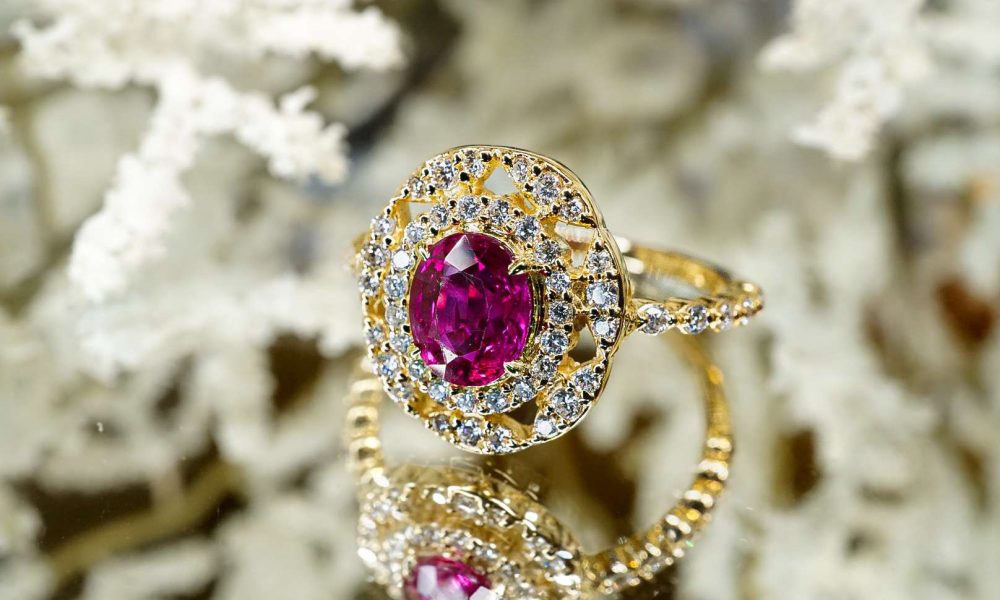
A Ruby Diamond Ring
Ruby Mining and Sources
The quest for these precious gemstones takes us to exotic locations like Myanmar, Thailand, Sri Lanka, and Mozambique. These regions are known for producing high-quality rubies, each with its unique shade and character. The mining process requires skill and patience to carefully extract the gemstones from the earth while preserving their natural beauty.
Evaluating the Quality and Ruby Price
At the heart of evaluating rubies lies a complex interplay of factors that shape their value, with color, clarity, cut, and carat weight standing as pivotal benchmarks. Among these, the pursuit of an intense red hue, famously dubbed “pigeon blood,” holds a place of utmost reverence, commanding premium prices due to its rarity and arresting visual impact.
This coveted color is an emblem of rubies’ enduring allure, drawing the gaze and igniting a spark of emotion. Moreover, the magnetic charisma of rubies soars to new heights when they harmonize with the brilliance of diamonds or the velvety embrace of sapphires.
These captivating unions forge jewelry pieces of exceptional beauty and intrinsic worth, encapsulating the essence of each gem while elevating them collectively into an iridescent symphony of elegance.
Exploring Star Rubies: A Celestial Delight
A captivating natural phenomenon known as asterism can enchant certain rubies, unveiling a mesmerizing spectacle of a star-like pattern, which gives the ruby the name “Star Ruby,” that gracefully emerges on its surface when illuminated by a solitary source of light.
These extraordinary star rubies, a rarity within a rarity, cast a spell of fascination with their celestial adornment, drawing admirers into their enchanting world.
This unique feature imbues them with an unparalleled mystique, elevating their allure to an even greater level and ensuring their place as truly exceptional treasures in the realm of gemstones.
Myths, Legends, and Symbolism Surrounding a Red Ruby
Across diverse cultures, the radiant history of rubies is woven with myths and legends that have ignited imaginations for generations. In ancient India, these gems were held as guardians, believed to shield wearers from harm’s grasp, infusing them with a sense of invulnerability.
Meanwhile, the Burmese attributed such reverence to rubies that they eloquently dubbed them “pigeon blood ruby,” a moniker echoing the gems’ intense red hue. This vivid symbolism remains an echoing refrain through time, endowing a ruby gem with an enduring significance as profound expressions of love and unwavering courage, a sentiment that continues to captivate hearts to this day.
Healing Properties Associated with Ruby Gemstones
Beyond their exquisite aesthetic allure, rubies are believed to hold metaphysical properties that resonate with the core of human existence. Widely regarded as invigorators of the body’s life force, these precious gems are thought to infuse wearers with a renewed sense of vitality and impassioned energy, igniting the spark of passion within.
Additionally, the connection between rubies and the heart chakra is a profound one, fostering emotional well-being and kindling a profound connection to feelings of love and unwavering devotion. In this manner, rubies transcend being mere adornments, evolving into powerful vessels that channel and amplify the deep emotions that shape our collective human journey.
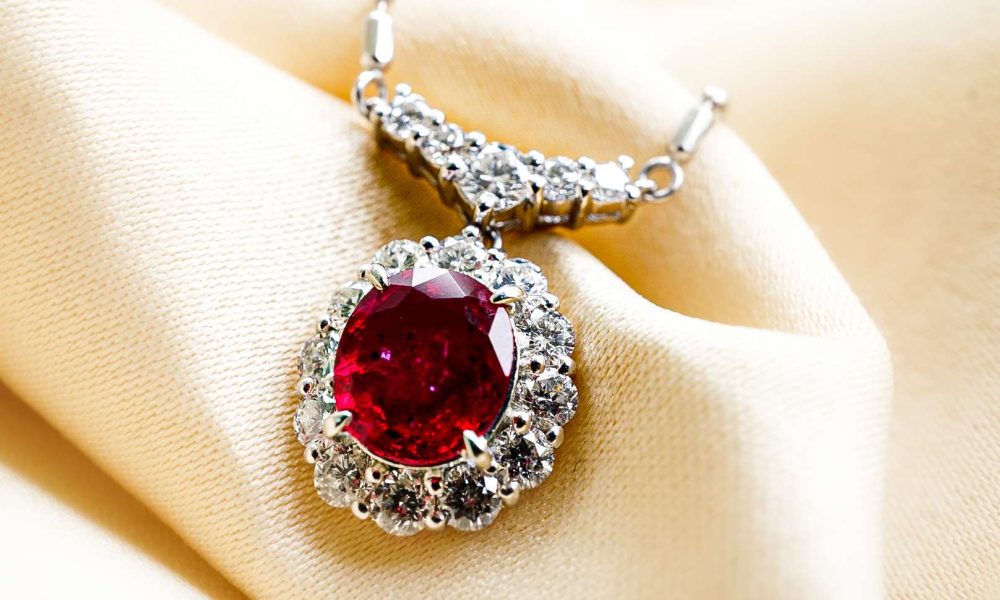
A Ruby Diamond Pendant
Caring for Your Precious Ruby Jewelry
Preserving the enduring allure of your treasured ruby jewelry necessitates meticulous care. Delicately cleanse your pieces with a mild soap and water solution, sidestepping the corrosive touch of harsh chemicals. Safeguard their splendor by storing them apart from other items, thwarting the risk of unsightly scratches.
As a measure to sustain their lustrous gleam, contemplate entrusting your precious rubies to professional cleaning and periodic inspections, ensuring they remain radiant and resplendent throughout the passage of time.
Investing in the Timeless Elegance of Ruby Gemstones
Amidst the ever-shifting tides of jewelry trends, the enduring and ageless elegance of rubies stands unwavering. Their intrinsic allure has consistently transcended the ephemeral nature of fads, cementing their position as gems of lasting value. Sought after by collectors and investors alike, rubies stand as a testament to the fusion of timeless beauty with lasting investment potential.
Be it the understated grace of a pair of classic ruby stud earrings or the captivating splendor of a radiant necklace, embracing ruby jewelry is an invitation to possess not only a piece of history but also an embodiment of beauty that remains eternally relevant.
Famous Ruby Gemstones That Shine Like Stars
Within the vast expanse of ruby gemstones, a select few emerge as celestial luminaries. Among them, the illustrious “Sunrise Ruby” and the resplendent “Mogok Ruby” command attention with their extraordinary proportions and the captivating depths of their mesmerizing color.
These rare jewels transcend the ordinary, captivating the world’s imagination with their unmatched rarity and breathtaking beauty. In doing so, they carve an indelible mark upon history, securing their place as luminous treasures that have both captured and defined the essence of precious elegance.
Ruby Jewelry: From Earrings to Necklaces
Adorning the ears of royalty and gracing the necklines of celebrities, ruby earrings and ruby necklaces embody a timeless allure that transcends eras. The opulent crimson hue of rubies infuses a touch of sophistication into every ensemble, elevating it to a realm of timeless elegance.
Whether adorning oneself with the understated charm of classic ruby stud earrings or donning an intricately designed necklace that glimmers with these precious gems, each piece is an embodiment of versatility and endurance.
Rubies, with their profound richness, stand as steadfast companions for any occasion, a testament to their innate ability to infuse every moment with an air of regal refinement.
The Alluring Ruby Diamond and Ruby Sapphire Combinations
Blending rubies’ allure with diamonds’ brilliance or sapphires’ velvety blue yields breathtaking jewelry. The play of colors and light creates irresistible combinations, whether in a statement ring or an elegant pendant, forming an artistic synergy that captivates the eye.
Sustainability and Ethical Sourcing
In today’s conscientious landscape, sustainability and ethical sourcing have gained prominence in the realm of ruby gemstones. Consumers are advocating for responsible practices, urging transparency and ethical considerations across the supply chain.
This movement is reshaping the industry, promoting fair labor and minimizing environmental impact, all while ensuring that the splendor of rubies aligns with social responsibility, enriching both wearers and the world.
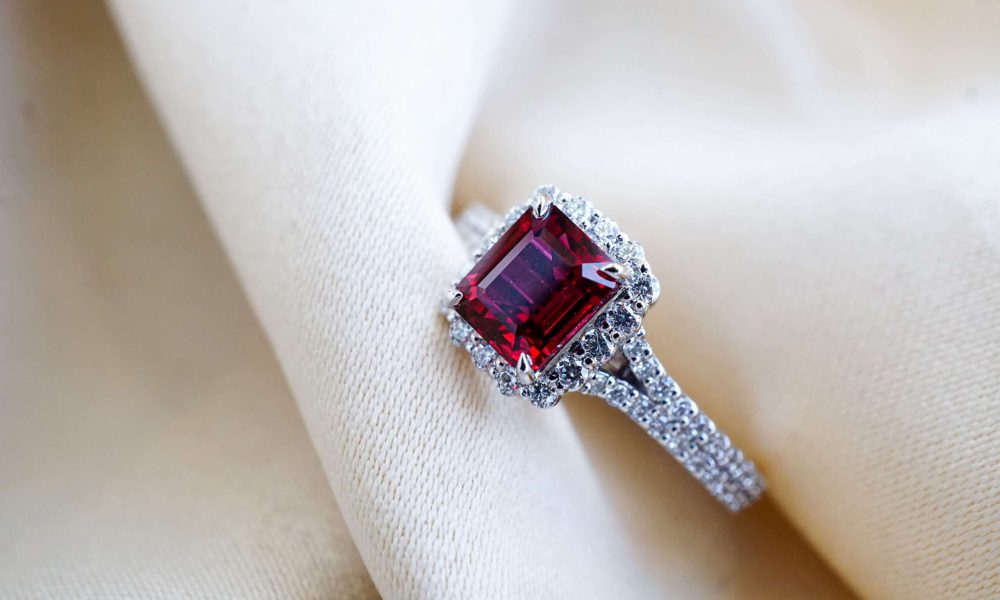
A Ruby Diamond Ring
Final Thoughts
In the enchanting realm of gemstones, the ruby stands as an exceptional jewel that weaves a tapestry of timeless allure and profound symbolism. Its journey spans through rich historical narratives and across the expanse of awe-inspiring physical properties, unfailingly entrancing the world with its remarkable essence.
Whether drawn by the luminous intensity of its vibrant red hue, the echoes of cultural significance it carries, or the undeniable splendor that it radiates, the ruby remains an enduring treasure to be held close to the heart.
A gem that has kindled the flames of passion across civilizations and continues to do so today, the ruby serves as a steadfast reminder that its allure transcends time, embodying emotions, histories, and the very essence of human fascination.
FAQs About Rubies
A ruby is a precious gemstone belonging to the corundum family, known for its striking red color.
Rubies are formed deep within the Earth's crust under high heat and pressure, where the presence of chromium gives them their red hue.
"Pigeon blood" refers to the vivid red color of certain rubies, highly prized for their intense hue and exceptional value.
Yes, rubies are a durable gemstone with a Mohs hardness of 9, making them ideal for daily wear in various jewelry pieces.
Yes, some rubies exhibit asterism, creating a star-like pattern on the surface under single light sources, known as a ruby star.
Rubies are the birthstone for the month of July, symbolizing passion and vitality.
Combining rubies with diamonds or sapphires creates captivating color contrasts and interplays of light, resulting in exquisite and valuable jewelry pieces.
Rubies are believed to promote vitality, passion, and emotional well-being. They are associated with the heart chakra, inspiring feelings of love and devotion.
To maintain the brilliance of your ruby jewelry, gently clean it with mild soap and water, avoid harsh chemicals, and store it separately to prevent scratches.
Yes, rubies with exceptional color, clarity, and size can hold and increase their value over time, making them sought after by collectors and investors.

